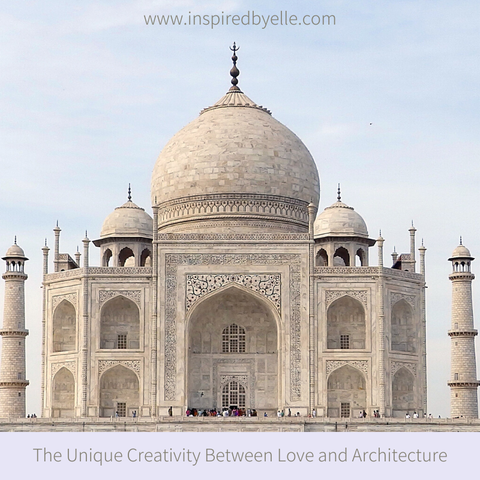The Unique Creativity Between Love and Architecture
The Unique Creativity between Love and Architecture

Nothing can be more powerful than love and when love is expressed in architecture, it becomes divinely romantic. Love has inspired an endless list of unique works of creative art. These range from songs like “Love of My Life” by Queen to the immortal play Romeo and Juliet, to architectural masterpieces like the Taj Mahal. The most beautiful thing about architecture is how it enables a person to express their innermost feelings, especially endless or tragic love.
But why does love spur such architectural creativity? Because love influences how we think about everything. Perhaps love should be seen as a potent way of inducing in us a sense of immortality, inspiring us to our highest levels of artistic creativity. In the words of Ralph Waldo Emerson, “In art, the hand can never execute anything higher than the heart can inspire.”
Love inspires creativity, expansion, and expression. It’s credited with inspiring some of the most awe-inspiring pieces of art and marvels of architecture.
If you want proof of how love can inspire unique creativity in the field of architecture, just at the majestic Taj Mahal in Agra, India. The Taj is a white-marble, beautiful mausoleum constructed by Shah Jahan, a Mughul emperor for Mumtaz Mahal, his beloved wife.
Mumtaz died in 1631 due to birth complications when giving birth to their fourteenth child. As she died with Shah Jahan by her bedside, he promised her that was going to erect the richest mausoleum for her and that he would never remarry. This pledge and the immense grief gave birth to an expensive, elaborate, and exquisite mausoleum in Agra that continues to awe millions even today.
The magnificent architectural monument is now counted amongst the world’s Seven Wonders, a true story of love that has continued to mesmerize many people beyond the borders of India with its bewitching creative beauty.
Often referred to as England's Grandest Folly, the Ashton Memorial is also known as the “Taj Mahal” of the North. It is located in Williamson Park, Lancaster and sits on top of a hill. Lord Ashton, a local industrialist and millionaire who at times is referred to as “the Lino King of Lancaster” had the grand structure erected in memory of Jessie, his second wife who died in 1904.
Externally, the 150-foot artistic dome is made of copper although the main construction used Portland stone. The steps were made using Cornish granite. The viewing gallery located on the first floor outdoor provides the visitor with superb views across Morecambe Bay to the surrounding countryside and the Lakeland fells as well as the distant mountains.
The story of Chatsworth House goes back to the Elizabethan era. It begins with Elizabeth Talbot, Countess of Shrewsbury who was married four times. It was after her second marriage to Sir William Cavendish that the Cavendish history as we know it today at Chatsworth House began.
Chatsworth House also forms the inspiration behind Pemberley, the fictional home in Jane Austen’s Pride and Prejudice owned by Mr. Darcy. Currently, the 12th Duke of Devonshire and Duchess of Devonshire are living at Chatsworth House.
Located on Heart Island in New York is a beautiful building that carries a tragic story. In 1900 the proprietor of Waldorf-Astoria Hotel, George Boldt commissioned a 300+ team of workers to build a gift for Louise, his wife. It was to be a 120-room castle overlooking Alexandria Bay. George’s love for Louse was so great that in terms of artistic design, he spared no expense. The design included Italian gardens, tunnel systems, and a drawbridge.
But the Boldt Castle romantic story was truly tragic. It was left unfinished following the tragic death of Louise months before it was completed. George Boldt never set foot on Heart Island again. For the next 73 years, this unfinished love memorial had been falling into disrepair. It was only 1977 when the Thousand Islands Bridge Authority took over the site and the castle was opened to the public. Funds from the tours were used to restore the castle to its intended glory.
The Petit Trianon was designed by Ange-Jacques Gabriel in 1762 at the request of Louis XV. It was originally built for Madame de Pompadour, the king’s mistress but sadly, she died 4 years before the completion of the building. Upon completion in 1768, the Petit Trianon was given to Madame du Barry who succeeded Madame de Pompadour as the emperor’s mistress. She decorated and continued to occupy the home until her death in 1774.
When Louis XVI took over the French throne in 1765, he gifted the Petit Trianon to Marie-Antoinette, his young wife, notably the most famous occupant of the French Palace. In 1867, the wife of Napoleon III, Empress Eugénie who was also a fanatic of Marie-Antoinette had the Petit Trianon converted into a museum. It was dedicated to the memory and life of Marie-Antoinette a function it continues to serve to this day.
Located in Kyoto, Japan, the Kodai-Ji Temple is a rarity as it was masterminded by a woman. It was constructed in 1606 and is officially known as Kodaiji-jushozenji Temple. The creativity behind this temple was Toyotomi Hideyoshi’s wife, Kita-no-Mandokoro. Toyotomi (1536-1598) was one of Japan’s unifiers and she wanted a temple that matched the level of her husband’s accomplishments.
Later, Kita-no-Mandokoro became a priestess at this specific temple, assuming the name Kodaiin Kogetsuni. The large and ornate structure consists of several buildings. This includes the central hall (Hojo) and the memorial (Kaizando) where she continued to pray that Toyotomi rest in peace. Kita-no-Mandokoro stayed at the Kodai-Ji Temple until she died in 1624. The sepulchre containing the two spouses is located on a beautifully decorated small mound behind the Kodai-Ji Temple.
Our exploration of the architectural creativity inspired by love would be incomplete without exploring the Swallow’s Nest. Constructed in 1912 in South Crimea near Yalta, this ranks among the most romantic Neo-Gothic style castles. Precariously perched on the Crimean Sea’s edge, the Swallow’s Nest is not perhaps what you would expect to find in a typical Neo-Gothic castle. Literally built on the cliff’s edge, parts of the patios and balconies actually extend beyond the face of the rock, jutting sharply into thin air.
Although architecturally classified as a castle, Swallow’s Nest cannot be described as a castle when defining one. Today it stands to give us a glimpse of what remains of Imperial Russia. The Castle was, however, originally named “The Castle of Love” before it became known as “Love Castle”. It started humbly as a wooden cottage and there is little proof that the Swallow’s Nest was built to commemorate a great love. It is more of a lovers nest.
Conclusion
Through history, human beings have always felt the desire to express their innermost feelings and creativity offers a great channel. Love is an expression to be enjoyed and shared by all. Creativity has always been surrounded by myths, the “Ah-ha” experiences, or the sudden ‘Eureka’ inspirational moments. But nothing ignites creativity like love and as Deepak Chopra concludes for us, “The highest expression of love is creativity.”
Sources:
https://www.scientificamerican.com/article/does-falling-in-love-make/
https://www.huffpost.com/entry/love-creativity_b_834235?guccounter=1
http://www.etajmahaltour.com/story-of-taj-mahal.html
https://www.lancaster.gov.uk/sites/williamson-park/ashton-memorial
https://leahandneil.com/2016/06/15/chatsworth-house/
https://househistree.com/houses/boldt-castle
https://mentalfloss.com/article/92202/8-architectural-wonders-built-name-love
https://www.japan-experience.com/city-kyoto/kodaiji
https://weburbanist.com/2010/02/10/architectural-love-story-10-castles-built-for-love/
Leave a comment
Comments will be approved before showing up.


